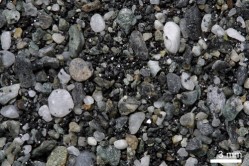|

Description
Heavy sand is the generic name for mineral sands with a higher specific gravity. When the parent rock is weathered and eroded, sand is washed downstream and deposited on the riverbed or beach. Properties include high specific gravity, hardness, chemical stability and resistance to grinding/erosion. In Taiwan heavy sand is generally found in rivers and beaches. Mineral content includes magnetite, ilmenite, monazite, zircon, rutile, titanite, dravite and garnet. Magnetite, ilmenite, monazite and zircon are the most valuable as they have defense and industrial applications.
Mineral Formation
When parent rock containing magnetite, ilmenite, monazite, zircon, rutile, titanite, dravite or garnet is weathered or eroded away, the heavier minerals settle in river beds or beaches to form heavy sand deposits.
Geographic Distribution
Found in riverbeds and beaches throughout Taiwan.
Mining History
The mining of heavy sand in Taiwan began during the Japanese colonial period. Zircon and monazite were discovered first in Keelung River in 1903 but there were insufficient quantities to merit mining. It was not until 1941 that the Japanese began mining heavy sand at Jhuwei in Taoyuan County and Madou in Tainan County. The mined zircon was then shipped to Japan. Magnetite mining was started in 1918 by the Japanese along the beaches between Danshuei and Jinshan. The sand was used for smelting iron.
A monazite survey was carried out in 1951 in Taiwan to determine the reserves of monazite and zircon. Since then the Ministry of Economic Affairs' mineral survey team, the Institute for Nuclear Energy Research and the Energy & Resource Laboratories have conducted further studies and surveys of heavy minerals in Taiwan. Between 1957 and 1979 the Veterans' Mining Industry Development Bureau of the Veteran Affairs Commission carried out magnetite mining around Danshuei and Jinshan. Mining operations ended when the deposits ran out. The Veteran's Mining Industry Development Bureau also set up joint ventures with the Luhaitong Mining Company(陸海通礦業) and the Shin Hai Rare Earths Company(鑫海稀土公司) between 1957 and 1983 to mine heavy sand along Taiwan's southwest coast. There has however been no mining of heavy sand in Taiwan since 1994.
Production
Heavy sand production in 1987 amounted to 4,744 tonnes. Production was 4,297 tonnes in 1998, 1,593 tonnes in 1989, 46 tonnes in 1990, 6,413 tonnes in 1992 and 180 tonnes in 1993. No further production was recorded after this date.
Mineral Composition of Heavy Sand
Mineral composition of heavy sand from Taiwan's southwest coast Heavy minerals (%)
Ilmenite Magnetite Limonite & Hematite Zircon Leucoxene Garnet Black Monazite Yellow Monazite Rutile Other Location: Tongshanjhou Waisandingjhou Wangyejhou Cingshangangjhou Fulun
Source: Ho & Lee (1963)
~Applications~
Magnetite is an importance source of iron ore and can be used for steel smelting. Ilmentite is an importance source for titanium and titanium oxide (TiO2). Alloys made from titanium with aluminum, manganese, iron and other metals are used in many applications while titanium oxide is used in dye, paint and glaze. Monazite is an important source of rare earth elements and it contains thorium, a radioactive element that can be used as nuclear fuel. Zircon is resistant to heat and corrosion, making it suitable for use in making fire-resistant materials, fire bricks and chemical engineering machinery parts. It is also the main source of zirconia and hafnium oxide. Those of high quality and color can be used as gemstones.
National Museum of Natural Science
|